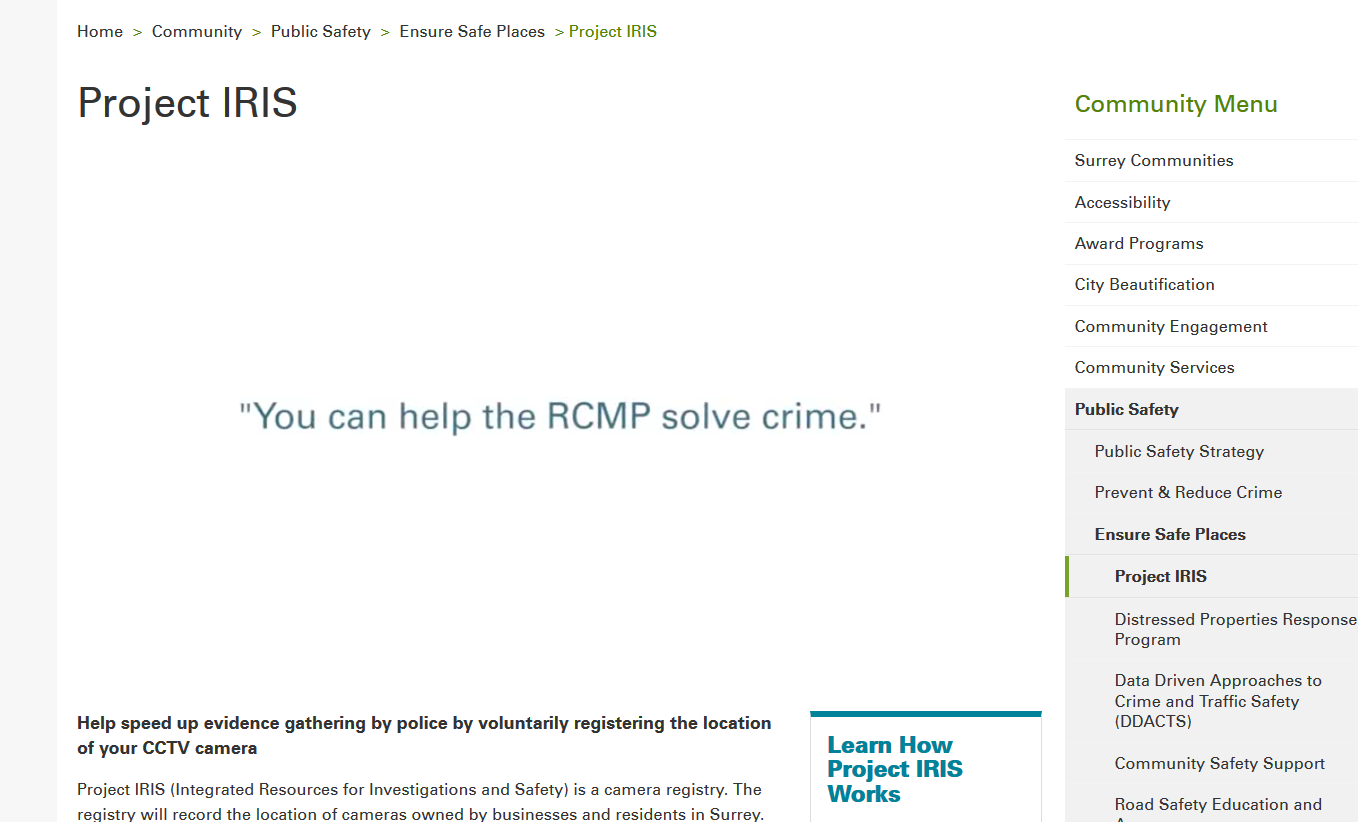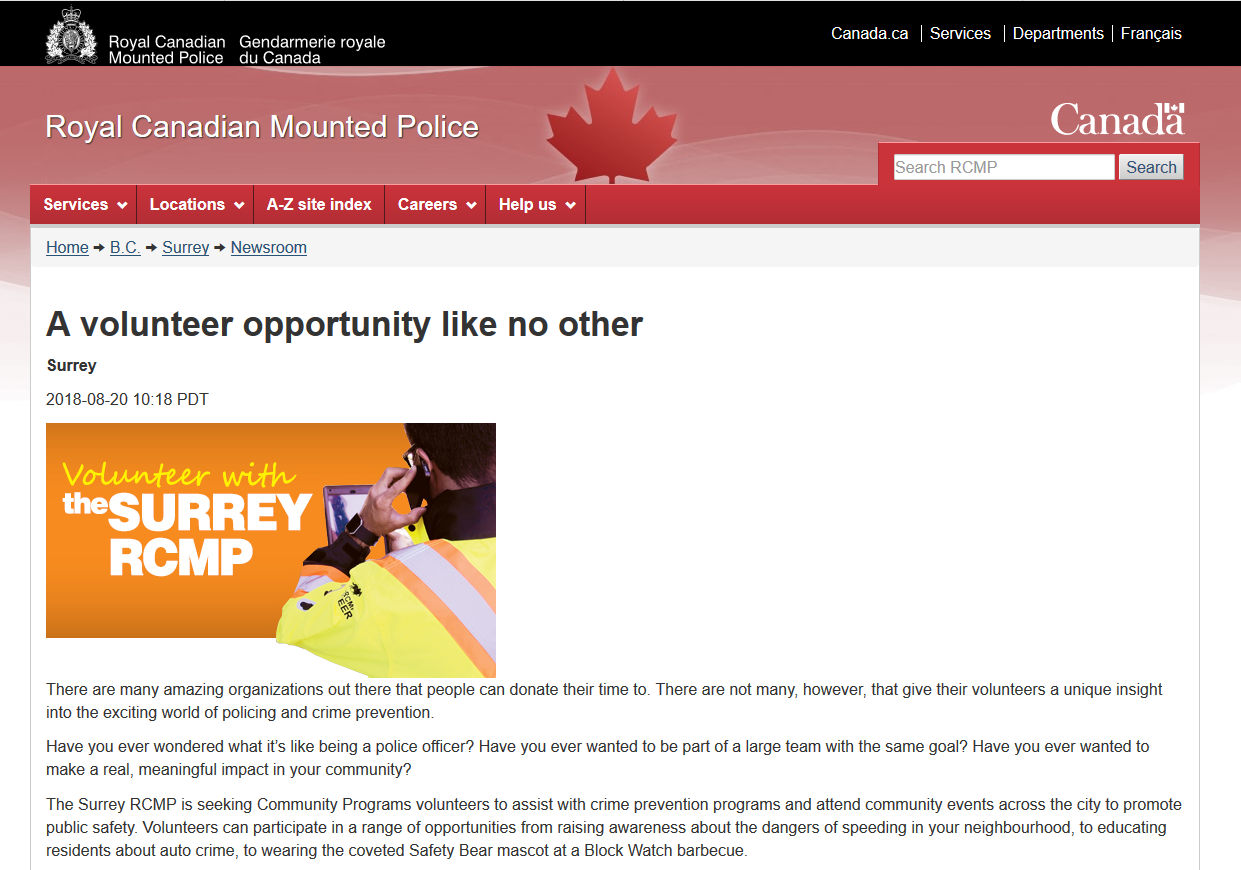
Cops Everywhere, Justice Nowhere: Layers of Policing in Surrey
People living outside Surrey likely have little idea of the extent to which we are policed in this “city of the future.” The Surrey RCMP uses a model of so-called “layered policing”—the extension of policing into all areas of social interaction and activity. Policing, surveillance, and regulation permeate all public spaces and areas of social life in Surrey, including our streets, parks, schools, community centres, malls, and even our homes.
In the school context, the RCMP employs what they explicitly refer to as a “wrap around” approach, but this approach extends well beyond the panic-based targeting of students. Policing in Surrey wraps around all social interaction in the city, not only through methods generally associated with policing (flyovers by helicopters, experiments with drones, and boots on the ground) but also through the extended networks and partnerships that characterize the “layered policing” model. Drawing in volunteers through recruitment and coercion, and infiltrating social services and community groups, layered policing works through, rather than simply over, communities.
Layered policing is driven by capitalist profit. Business owners organized in boards of trade and developers connected with City Hall want more police to improve the conditions of profitability in their investments in Surrey. But it is not purely a business initiative; layered policing strategies also coincide with the needs of police departments to justify their budgets by diversifying their services, as governments look to develop harm reduction services to complement classically repressive policing. Layered policing allows the Surrey RCMP to access new funding sources in the form of community development grants, while masking their policing functions behind a community screen. Policing the social disorders that stem from inequality serves business interests, and monopolizing social services serves the interests of police departments seeking to increase their budgets and hold on society.
The investment-based economies and social program cuts of neoliberal austerity regimes create crises within working class communities. To maintain this social order, that crisis needs to be managed lest it give rise to unmanageable resistance. Layered policing is an efficient, even necessary, means of control and regulation that allows the causes of these crises to continue.
Layered Policing

In the context of declining crime rates, policing agencies in Canada and elsewhere have been forced to develop new models of policing in order to maintain or increase their budgets. Layered policing (also called plural or tiered policing) has been one significant approach to broaden and expand the practices, institutions, and personnel involved in policing. Since layered policing pulls private security firms, businesses, so-called community partners, and individual civilians into the orbit of policing, it can be understood as a form of public-private partnership, which raises questions about the interests it serves. Layered policing increasingly brings low-level activities within the purview of the criminal justice system through the expansion of surveillance and criminalization. Layered policing targets poor, homeless, and racialized people for activities like squeegeeing, panhandling, sex work, minor drug use or sale, graffiti, and littering.
Layered policing gives police more flexibility in funding and personnel, at lower cost. They can rely on auxiliaries to deal with matters viewed as less important (traffic) while deploying officers to other areas (gangs, public order, etc.). And volunteer associations can put eyes and ears on the ground in a cost effective but strategic way (essentially being undercover in the community).
The Surrey Model
The City of Surrey has implemented the layered policing model, expanding policing structures to include formal and informal, public and private, and paid and volunteer elements. Formal and paid players are straightforward; they include private security and, of course, the RCMP. Formal policing takes up more than 20% of the City’s $737.2 million in expenses. In 2017, Surrey spent $152.8 million on RCMP, up from $148.4 million in 2016, and $133 million in 2015. There are about 777 RCMP officers actively working in the Surrey detachment. Fifty-eight more work in integrated teams. Surrey is pushing the federal government for an extra $10 million in funding for anti-gang programs for 2019.
Volunteer programs like street ambassadors (for Business Improvement Areas) and the Surrey Crime Prevention Society serve as transmission belts to recruit people into formal policing, while also providing access to community contacts for internal community surveillance. Auxiliary officer positions and post-secondary practicum placements work in a similar way. Volunteer positions hold out the promise of formal paid employment—careers in policing. They are posed as resume builders, sources of reference letters, and/or entry level positions in the force.
These volunteer programs are driven by police seeking to secure and expand funding and operations, city government seeking investments, political parties seeking supports, businesses and their associations (the Surrey Board of Trade, the various Business Improvement Areas) seeking development and conditions of profitability, and developers seeking to profit from gentrification and displacement of working class and poor communities.
Police Training and Recruitment Posing as Community Care
The presence of RCMP is fairly straightforward. So too is the presence of private security on streets, malls, and plazas. But there are also less obvious layers of policing that escape attention. These can pose as community-oriented initiatives, oftentimes playing on desires of youth to volunteer in their communities.
One significant example is the Surrey Crime Prevention Society. Although it presents itself as a community resource for Surrey residents who are concerned about their city to get involved in community care work, it is actually a police training and recruitment operation which not only provides policing functions but serves as a recruitment and preparation service for police. And it operates in a highly repressive way, targeting low-level, socially harmless activities.
The Surrey Crime Prevention Society takes a “broken windows” approach to policing—a discredited theory, which posits that serious crime can be prevented through the targeting of low-level crime and visible signs of disorder (such as broken windows, graffiti, or public drug use). Rather than prevent crime or violence, broken windows policing functions to accelerate gentrification and social exclusion.
Through this broken windows approach, the Surrey Crime Prevention Society does the work of the cops in harassing homeless and poor people, criminalizing drug users, spreading moral panic discourses, and establishing snitch networks. Their commitment is to the Board of Trade and Business Improvement Areas, and they work closely with the cops. They are not a community care program, but an institution of policing, surveillance, repression, and poor bashing.
“Soft Cops”

In Surrey, there are a number of covert policing groups providing “softer” policing models. They are, in their own ways, quite dangerous. First, because they operate under the radar, posing as community groups or community resources. Second, because they use their connections and proximity to communities to perform surveillance and recruitment. They mobilize real fears within communities about gangs and violence, as well as feelings of social isolation and disconnection that are part of life under capitalism, in order to legitimize the expansion of police power. Finally, they draw attention and resources away from real community groups, which are desperately needed.
The most prominent of such groups in Surrey are Yo Bro Yo Girl and Surrey Kids Play. These groups are structured, overseen, and guided by police and by the aims of policing in Surrey. They are oriented toward connecting cops to youth, but frame recruitment as an incidental outcome rather than an intentional pursuit (“Oh look, one of our kids just happened to become a cop”). Given their sports-first and social networking approach to youth engagement, they are able to get police hooks into youth, families, and communities in ways that more openly repressive policing approaches cannot.
The Dramatization of Evil in Our Schools
Police school ambassador and “wrap around” programs have been brought into Surrey schools under the guise of fighting gangs. What they do in practice is render poor and racialized children and youth as gangsters in the making. Sociologists call this construction of children as potentially dangerous “the dramatization of evil.” Authorities render the harmless, even playful, activities of youth as threatening by treating them as potential gateways to gangster behaviour or gang recruitment. They treat the children themselves, not specific activities, as evil. In Surrey these ambassador programs disproportionately target racialized youth—a testament to the racism of the approach of staffing schools with police and pseudo police.
The effects of interventions rooted in the “dramatization of evil” logic, like the wraparound program, are to separate and isolate students and bring them under close observation and regulation outside of their social networks and supports, rendering them more vulnerable to the intrusions of police and social workers.Working with high school students in Surrey, I have seen kids harmed by repressive programs that remove them from their schools, sometimes in the middle of term,and move them to new schools or learning centers that are hours away from their homes, friends, family, and communities, and where the have fewer resources and supports. All in the name of gang prevention that the City trumpets as a success.
All that those kids might have done to fall afoul of authorities is attend a scuffle on the street (not even on school grounds or during school hours) or send some insensitive social media message. Schools and cops get to say they diverted these kids from the gang life—but in many cases, there is no evidence to suggest these kids are likely to become gang-connected in any way. There is no reporting on negative impacts of these interventions—whether they result in kids dropping out or taking longer to finish school, changing their interests or expectations for their futures, becoming depressed, etc. All that matters is they do not become gangsters. It is a circular, self-reinforcing logic, and kids get hurt within it.
Conclusion
The recent Surrey Gang Violence Prevention Task Force report made headlines with the claim that gangs are recruiting children as young as ten years old. The City and police provided no details or real evidence, but in classic moral panic fashion, the claim has generated enough fear on its own to justify extending the reach of cops even further into schools and youth services. There is clearly a lot of work to do to break through dominant police narratives that frame discussions of safety and fear: we need to confront the multiple layers of policing that operate freely throughout our city and provide real community alternatives to police in Surrey. We can begin by challenging the Surrey model of policing, which legitimizes and normalizes the infiltration of police into all areas of our lives.
